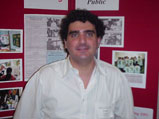Overview Can archeology help students understand America's past? In Boston and other construction site areas throughout the nation, the answer is yes. A class of Autistic high schoolers research The Big Dig known as the Central Artery/Tunnel project the "largest most complex and technologically challenging highway project in American history." As students complete a virtual tour of artifacts excavated from their city's neighborhoods, they visualize how Native American and colonial peoples lived. They visit the Big Dig Archaeology Lab and meet an urban archeologist who eagerly accepts their offer to help out. During weekly lab sessions, these students learn to perform tasks related to the preservation of objects. They examine recently excavated artifacts, sort them and meticulously wash away centuries’ worth of dirt, dust and salt. While they engage in on-going reflective dialogue with the archaeologist and her colleagues, windows open to literacy activities, as well as career related pursuits. Examining the urban archeologist's resumé leads to an investigation of what it takes to work in the field. The young investigators use Alpha Smart technology to write biographies and poems. For the final Archaeology Expo at the lab, they share their collective knowledge and products through oral presentations and poetry readings.
|
Classroom
Activities
|
Community
Activities
|
Career
Activities
|
||||||||||||||||||||||||||||||||||||||
|
|
|
| Learning Standards English Language Art |
|
| • | Use various formats and technology to complete and enhance work. |
| • | Use telecommunications to share information and ideas. |
| • | Connect reading with own and others’ experiences. |
| • | Understand and use the writing process effectively. |
|
Learning Standards History and Social Studies |
|
| • | Obtain information from a variety of sources. |
| • | Make connections between past and present. |
| • | Identify, employ reference materials, including primary source documents and information technologies. |
| • | Conduct historical and social studies research. |
|
School to Career Competencies |
|
| • | Develop Communication & Literacy Skills. |
| • | Use Technology. |
| • | Act Professionally. |
| • | Take Responsibility for Career & Life Choices. |
| • | Organize and Analyze Information. |
| • | Complete Entire Activities. |
| • | Interact with Others |
Assessment Informal assessments include teacher notes documenting students’ class work, individual contributions to group products. Formal assessments involve teacher grading the student journals, haiku, biographies and computer skills.
Software or Materials Used For bio sketches, haiku, journal writing AlphaSmart 3000, Microsoft Works, and Clip Art Web Sites; for computer slide shows: Microsoft Office PowerPoint; for photos: disposable cameras; for literature on the project: The Big Dig by Dan McNichol, 2000: Silver Lining Books; The Big Dig at Night by Dan McNichol, 2001: Marboro Books; for introductory books on archaeology: Breaking Ground, Breaking Silence: The Story of New York's African Burial Ground by Joyce Hanson and Gary McGowan, 1998: Henry Holt & Company; Eyewitness: Archaeology by Jane McIntosh, 2000: D.K. Publishing.
Web Sites AlphaSmart® 3000 Keyboard, Citizenship Education: Archaeology in the Local Community, Archaeology Adventure
Keywords AlphaSmart 3000, archaeology, archaeologist, artifact, Big Dig, biography, Boston, career exploration. Commonwealth Museum, Central Artery Tunnel Project, excavation, haiku, history. interview, journal, pamphlet, past, poetry, resume, service learning, transportation, urban archaeology
Final Words Besides being grateful to Ellen Berkland the urban archaeologist who allowed our students to make connections-- big and small-- to the world of The Big Dig and beyond, we want to pay tribute to Dwight Barnett, Charlestown High's extraordinary Social Studies teacher who suggested this partnership. When students work, shoulder-to-shoulder with peers in an archaeology lab, they learn the role, responsibilities and chores of the army of Big Dig workers. Hands on contact with artifacts provides a powerful kinesthetic tool and allows them to become literally grounded in their city's past.
Teacher Tip Make sure students understand that archaeology includes activities as mundane as using a toothbrush and a bucket of water to clean pottery shards in municipal building's basement lab, or as exciting as unearthing relics from the days of ancient pharaohs. Although our students focused on meticulous tasks, they also improved their oral communication proficiencies as they shared washing buckets with teammates. Becoming an integral part of an archaeological work-team is a perfect way to hone life skills and critical thinking.

E-mail contact John Deyab jdeyab@juno.com; jdeyab@charlestown.boston.k12.ma.us
Teacher Bio John Deyab teaches Autistic students at Charlestown High School, a School to Career School. As a Lead Teacher, he is certified in secondary English and Moderate and Intensive Special Education. John's extensive portfolio includes a Master of Fine Arts from Columbia University School of the Arts, a Master of Education from Harvard Graduate School of Education, an additional Master of Education (Special Education) from Northeastern University, and a Certificate of Education in Therapy for Specific Reading Disability from Massachusetts General Hospital. Along with facilitating Best Practices workshops, he has worked as a Boston Public Schools Individual Education Plan Trainer and also serves as a Department of Education MCAS Alternative Assessment Trainer.
Subject Areas English Language Arts, Communication, Social Studies, Life Skills
Grade Levels 9 - 12
Students Intensive Special Education students diagnosed with Mild-Moderate-Severe Autism. Can be adapted for all High School English and Social Studies students
